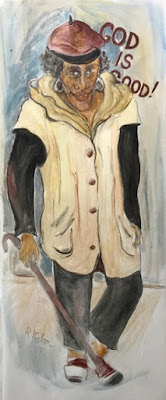My
best friend, – for over thirty years - died about a decade ago. In addition to
fond memories, she left me her words of wisdom, aphorisms from her childhood in
pre-Nazi Europe. I can occasionally dredge one up but unfortunately, didn’t
write them down at the time and have forgotten most of them.
Dina
Pisé was born in Lithuania in the late 1920s. Her idyllic childhood came to an
end when the Nazis invaded her home town, Kovna, murdering her father and
brother while she watched and sending her and her mother to a German work camp
where she spent the remainder of the war. Weeks before they were to be
liberated, her mother died of typhus fever. Not the most auspicious way to
enter adulthood but a testimonial to how human beings can live through
unbelievably dire experiences. She not only survived, she lived life to the
fullest, refusing to dwell on the horrors she had witnessed. She would not
participate in Shoah memorials; the past was dead and as far as she was concerned,
would stay that way. I remember her saying that the Nazis had robbed her of her
childhood and she was not giving them any more of her life.
After
coming to this country from a DP camp in Germany, she married, had a child,
divorced and remarried a brilliant French entrepeneur and became an artist. She
was exotically beautiful, had lots of friends and lovers, gave great parties
where she cooked marvelous Eastern European food, played the guitar and sang
melancholy Russian love songs. Her Friday night poker games were legendary, a
“hot ticket” invite; only men, no wives allowed. (if you knew their wives, you
wouldn’t have invited them either). Most of all she became a sculptor, creating
a house full of life-sized figures made of paper mache or stuffed muslin. Her
work was wise and loving and witty, a chance to recreate in art some of what
she had lost in life.
I
still remember some of her sayings, and, like most folk wisdom, they were
remarkably accurate. I think most of
them were Russian or Yiddish in origin, but universal in meaning. At one time,
I thought about collecting them and turning them into a book, but
unfortunately, I never got around to it, and then she was gone. I have forgotten most of them, but every once
in a while one will pop into my head. Although it’s a little late, I’ve started
writing them down and thought I’d share a few that I remember:
1)
Three heads can’t sleep on
one pillow.
Meaning, we never really know the truth of
what goes on in someone else’s life. And, as far as marriages are concerned,
you can never believe what the couple tells you. Even the two heads involved
have trouble figuring it out.
2)
She exchanged good shoes for
slippers.
This
was her comment about a friend of ours who was noted for having frivolous
lovers, none of whom were equal in quality to her rather dull but devoted
husband. (see #1)
3)
If he were mine I would
drown him.
This
referred to my late husband who got on her nerves.
The
images in this post were taken of the two of us about forty years ago for a
joint exhibit held at the Art Barn in Greenwich. We even looked like sisters.







































